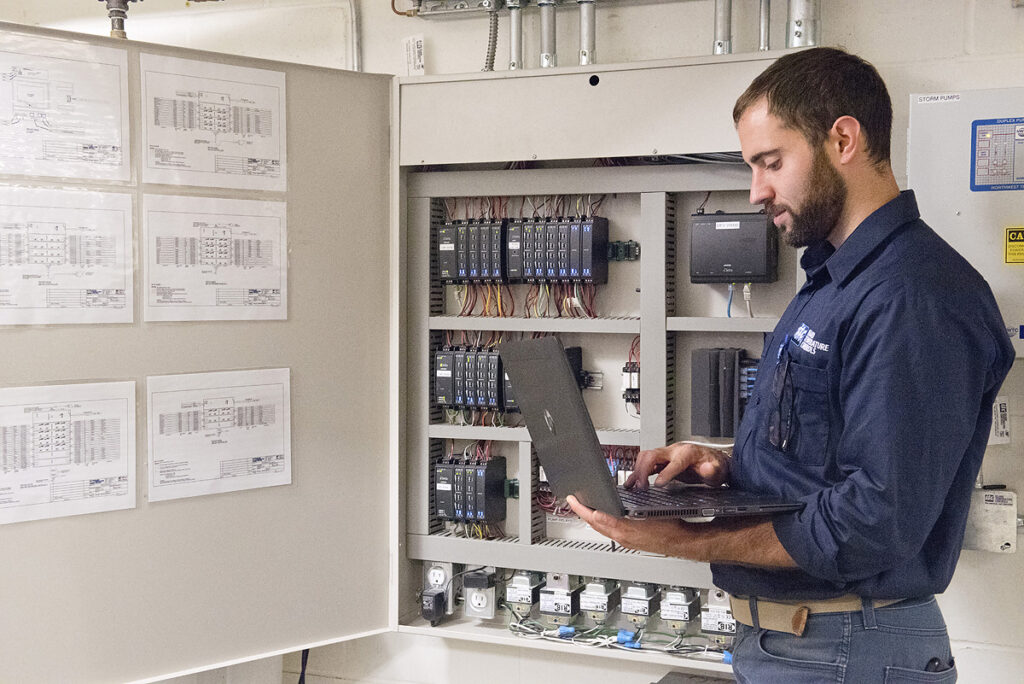The vision of today is a healthy planet for tomorrow
----------
We are committed to building a sustainable future. It is our goal to meet the needs of the present without compromising the ability of future generations to meet theirs. We have embraced various programs and initiatives that enhance our community and foster environmental responsibility.
At Island Temperature Controls, we recognize our role in environmental stewardship. Driven by our core values in sustainability, we continuously seek out methods and means to reduce our ecological footprint. We ensure green thinking is implemented in our day to day operations, from our extensive recycling, waste diversion and composting programs to recommending energy efficient solutions to our clients. We have consciously made the decision to introduce battery electric vehicles into our fleet to decrease net CO2 emissions.
Our multi-disciplinary team of HVAC specialists are constantly pushing the boundaries of efficient design, saving our clients money while conserving valuable resources. We remain diligent in staying up to date with breakthroughs in renewable energy, smart technology and green practices in an effort to contribute to a cleaner future.



Eight Ways to Conserve Energy by Improving HVAC Efficiency
Article by Grainger Editorial Staff
----------
Energy conservation is an integral part of commercial facility operations. Managing heating, ventilation and air conditioning systems (HVAC) through effective operation and maintenance is a best practice for conserving energy at your facility.
Here are eight areas of focus for HVAC maintenance and management to help improve overall energy efficiency:
Overseeing system boundaries by controlling heating and cooling to designated spaces can improve HVAC energy efficiency by as much as 20%. Boundaries can be adjusted according to the operating environment and season. A garage or loading area may not be heated or cooled at all, depending on the time of year. An open warehouse may have open entrances and doors at times in between seasons, but be sealed and heated or cooled at other times. An energy audit or commission for energy conservation in new buildings requires that system boundaries be clearly defined to know what those settings should be and when, where the boundaries lie and how airflow from HVAC ducting should be directed.
A programmable thermostat positioned to regulate air current and temperature to provide reasonable comfort levels at various times of the day and year creates an economical heating and cooling operation. A pre-set schedule includes programming heat or air conditioning to maintain temperatures for specific time blocks within a day. Adjusting the temperature settings for rooms that are not occupied through the day or night can save as much as 10% in energy consumption.
Automatically controlling the speed, output and run-time of HVAC equipment such as fans, chillers and compressor motors allows the entire system to be controlled so as to provide appropriate amounts of heating and cooling. For example, the installation of a variable air valve into the air system of an Indiana school was used to regulate airflow. This and other programmable energy features saved about 25% on the school’s electrical bills while maintaining student comfort at appropriate times of each day throughout the school year.
Ensure that equipment set points are reasonable to achieve desired comfort levels, and that they aren’t working more than necessary. Equipment such as fans and blowers should be set to run at speeds that deliver the required air demanded by the space boundaries they serve. Systems often deliver more than what is needed and are not set properly. They consume more power to produce a greater heating or cooling effect than is required, reducing energy efficiency. Implementing calculated set points will avoid this and result in energy savings.
Raising the temperature of the system’s chiller water supply to a level that is able to achieve required temperature settings and levels will help conserve energy. Depending on the configuration of the system, controlling the temperature of cooling water to your chiller, within manufacturer’s guidelines, can achieve a desired comfort level and consume less power. In fact, this can be a huge energy saver as the compressor does not have to work as hard while maintaining the desired comfort level. Be mindful that a modest change in temperature setting may be all that is needed when the season changes. This alone could result in notable energy savings.
Heating and cooling with variable speed alternatives for fans, blowers, motors, and other components have improved energy efficiency for many commercial facilities. Over the last decade, air conditioners and thermal equipment have incorporated variable speed features to create more cost effective and efficient operating systems. Efficiency lies in the ability to configure settings properly and in preventing motors, fans and operational components from running at their maximum designed speed at all times. Variable speed control allows the equipment to be set for what is necessary, less than 100%, and still meet the heating and cooling demands.
Achieving facility climate conditions while conserving energy relies on an appropriate HVAC compressor and chiller size. Purchase enough tonnage and capacity for your systems based on the temperatures demanded throughout the year. Major apparatus in small areas will run at optimal speeds and consume large volumes of power, while a small unit is placed under strain for larger areas, decreasing comfort – if the wrong size equipment is used.
Ensure that HVAC systems and components are on a disciplined, time-based maintenance schedule and that data is recorded promptly. Develop a standard HVAC maintenance checklist that Includes, at a minimum, the following actions:
- Audit your HVAC size for the size and capacity of any equipment additions. Statistics have shown that many contractors often incorrectly install oversize units. According to the ACCA, it is better to install a smaller unit that can maintain the load. Larger equipment decreases energy conservation, hikes utility bills and compromises air conditioner longevity.
- Clean and change air filters and check thermostat set points regularly. Optimal HVAC efficiency is achieved with scheduled maintenance. Filters clogged by carbon particles and dirt must be replaced, coils cleaned to minimize overheating, and wear on components determined.
- Thermostat assessments can detect poor set points or faulty operation causing constant energy consumption. Faulty thermostats require immediate fixing or complete replacement to restore a comfortable, efficient space.
- Check for refrigerant leaks regularly. A leak will reduce the system’s effective operation and lower its efficiency. If not repaired, the capacity of the system can be compromised, and permanent damage could result. When units are unable to deliver a powerful and efficient output, compressors may be overworked because of leaks in the system. A careful assessment of leakage within the unit and the system provides HVAC longevity as well as efficient operation.
- Check all drain and pan drip lines regularly. Should system condensate connections become blocked, the excess moisture can migrate and spill out of drip pans, causing a multitude of problems. An accumulation of water also increases risk of fungal growth and mold.
This eight-step approach to managing and maintaining your HVAC system will ensure optimal performance, lower energy consumption and suitably meet the needs of your facility and its inhabitants.

